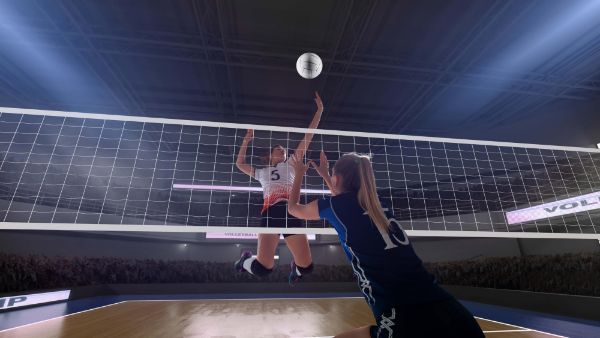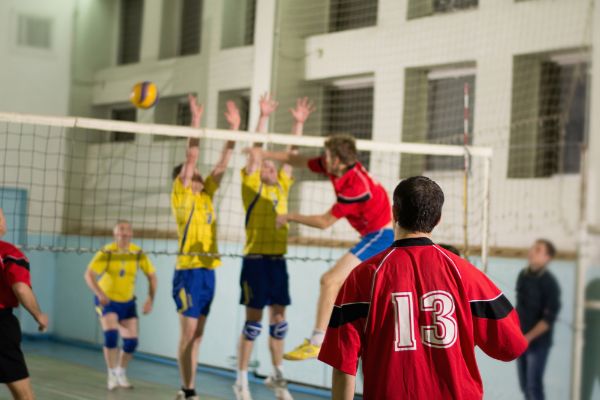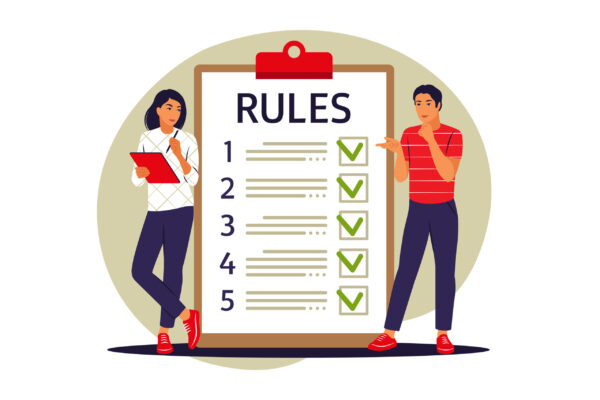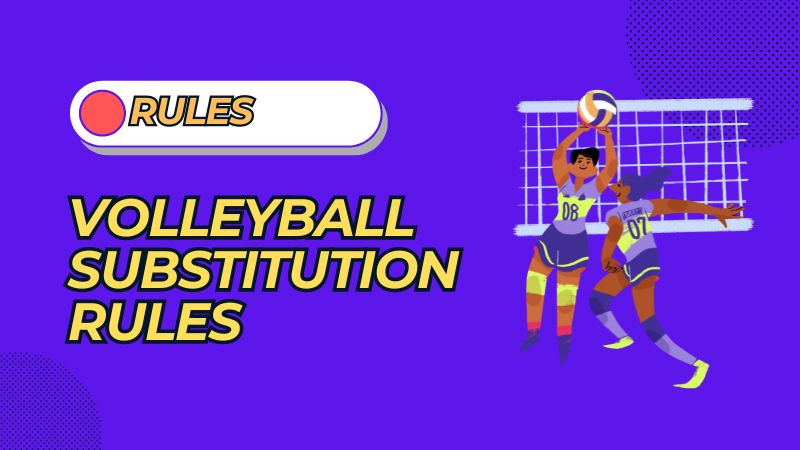Mastering volleyball substitution rules can significantly enhance a team’s strategy on the court. These rules straightforwardly harbor nuances that might perplex new players and spectators.
Substitution in volleyball isn’t just about replacing one player with another. It’s a tactic, optimizing the team’s formation based on the unfolding game scenario.
However, rules vary across leagues like FIVB, NCAA, and USAV, adding a layer of complexity. It’s a game within a game where every decision could tilt the match in favor of one team.
Understanding volleyball substitution rules is essential. It allows players to adapt during a match and enthusiasts to appreciate the tactical depth of this exhilarating sport.

What Is a Substitution in Volleyball?
A substitution in volleyball occurs when one player on the bench replaces a player on the court. This tactic is crucial for introducing fresh energy or a different skill set, potentially altering the game’s momentum.
How Do Substitutions Work in Volleyball?
To initiate a substitution, a player enters the substitution zone, a designated area outside the court but within the 10-foot line, signaling their readiness to swap places with a player on the court.
Substitutions can happen anytime the ball is not in play—between points, after timeouts, or before a set begins.
The FIVB rules allow only six substitutions per set, with a starter replaced only once per set and must re-enter in its original position. Domestic leagues, however, permit up to 12 substitutions per set, with no limit on replacing starting lineup players.
The reasons for substitutions are primarily tactical, for injury management, or at the referee’s discretion. Tactical changes help manage player fatigue or rectify poor performance. Injuries necessitate substitutions for player safety, and a referee might mandate a substitution in cases like a player’s expulsion due to misconduct.
The authorization for a substitution comes from the second referee, standing by the scorer’s table. In the absence of a second referee, the first referee, along with the scorer’s table, documents the substitution on the scoresheet.
Also, Read: How Many Sets Are in a Volleyball Match?
Volleyball Substitution Procedure FIVB
The substitution procedure in a volleyball game, governed by the International Volleyball Federation (FIVB), is a systematic process to ensure fairness and order during a match. The rules set by FIVB provide a framework that guides when and how substitutions should be carried out.
This framework not only maintains the game’s competitive integrity but also adds a layer of strategic depth. Now, let’s delve into the specifics of the substitution procedure under the FIVB rules.
Substitution Basics:
- A substitution is swapping a player on the court with a player on the bench.
- This can occur when the ball is not in play, between points, after timeouts, or before a set begins.
Player Re-entry:
- A player from the starting lineup can leave and re-enter the set, but they must return to their original position.
Substitution Limitations:
- Each team is allowed a maximum of 6 substitutions per set.
- The total number of substitutions per set is 12, with a maximum of 6 substitutions per team in any one set.
Authorization Procedure:
- Substitutions must be authorized by the second referee, who records the substitution and ensures it’s carried out correctly.
Strategic Implications:
- Substitutions are a precious resource for teams, used strategically to alter the game flow, manage player fatigue, or respond to the opposing team’s tactics.
The FIVB’s substitution procedure, meticulously defined, reflects the sport’s inherent complexity. Every move, including who gets to play and when can significantly impact the game’s outcome. Through these rules, FIVB ensures a structured yet flexible gameplay environment, enabling teams to exhibit their strategic prowess while adhering to a standardized protocol.

Volleyball Substitution Rules (USAV Rules)
In USA Volleyball (USAV), the substitution rules echo the standards set by the International Volleyball Federation (FIVB), with some variations to accommodate different levels of competition domestically. Let’s break down the key aspects of the USAV substitution rules, ensuring we cover the procedure and any unique aspects compared to international rules.
Substitution Procedure:
- The process begins when a player enters the substitution zone, signaling their intent to replace a player on the court.
- Substitutions can occur when the ball is not in play, such as between points, after timeouts, or before a set begins.
Substitution Limitations:
- Unlike the FIVB rules, which limit substitutions to 6 per set for each team, USAV rules allow up to 12.
- There is no limit on replacing players from the starting lineup in USAV rules, providing more flexibility for teams during a match.
Player Re-entry:
- Similar to FIVB, a player from the starting lineup can leave and re-enter the set but must return to their original position in the lineup.
Authorization Procedure:
- Substitutions must be authorized by the second referee, who records the substitution and ensures it’s carried out correctly.
Unique Aspects:
- The USAV also provides guidelines for different age groups and levels of play, catering to the diverse range of volleyball enthusiasts nationwide.
The USAV substitution rules provide a structured yet flexible framework, promoting fair play and strategic gameplay. These rules encapsulate the dynamic nature of volleyball, allowing for tactical adjustments and ensuring a seamless flow of the game across different levels of competition.
Beach Volleyball Substitution Rules
Beach volleyball is a fast-paced sport that differs significantly from its indoor counterpart, especially regarding substitution rules. Unlike indoor volleyball, where players on the bench can be substituted into the game, beach volleyball operates on a no-substitution rule. This change brings a different dynamic to the game, emphasizing the importance of each player’s continuous performance and endurance throughout the match. Now, let’s delve deeper into the specifics of this rule and its implications for the game.
No Substitution Rule:
- In beach volleyball, once the game begins, no substitutions are allowed, underlining the essence of endurance and strategy in this variant of volleyball.
Team Composition:
- Teams are composed of only two players, which means each player must be adept at both attacking and defending, unlike indoor volleyball, where players often have specialized roles.
Continuous Play:
- The no-substitution rule enforces continuous play, making every serve, spike, and save crucial. Each player must be prepared to cover the court’s expanse, demanding a high level of fitness and agility.
Tactical Implications:
- With no option to substitute, players must maintain a high level of performance throughout the game. This rule encourages strategic planning between teammates to cover the court and outmaneuver the opposition effectively.
The no-substitution rule in beach volleyball significantly impacts the game’s flow and the strategies employed by teams. It’s a test of endurance, skill, and on-the-spot decision-making, showcasing a different facet of volleyball where every move counts, and there’s no room for error.

How Many Substitutions Are Allowed in Volleyball?
The number of substitutions in a volleyball match varies based on the level of play and the governing body overseeing the competition. This diversity in rules accommodates the different strategic and player management needs across various volleyball environments: Collegiate and high school, club, and international (Olympics).
Collegiate and High School Volleyball:
In the United States, collegiate and high school volleyball levels permit each team up to 15 substitutions per set. This rule aims to balance the gameplay. It allows for managing player fatigue and offers the flexibility to adapt to various in-game situations.
Club Volleyball:
Club volleyball rules allow up to 12 substitutions per set for each team. This number maintains the game’s pace and ensures player safety while providing strategic subbing options.
International Volleyball (Olympics):
On the international stage, like in the Olympics, the substitution rules tighten. Each team is allowed a maximum of six substitutions per set. This rule pushes players to be well-rounded and capable of handling various game situations.
The limitation on substitutions at this level underscores the high preparation and endurance required. It reflects the game’s demanding nature on the international stage, urging teams to plan meticulously and players to perform at their peak.
Across different levels of play, the substitution rules significantly influence the game’s flow and the strategies employed by teams. Each level, with its unique substitution rule, makes each match a distinctive blend of tactical prowess and adaptability.
Also, Read: A Guide to Volleyball Player Positions and Role
How Does a Sub Enter a Match?
A player designated to enter the match as a substitute initiates the process by standing in the substitution zone, outside the court but inside the 10-foot line. If a second player is also entering the game, they stand outside the court but behind the 10-foot line. After the first player steps in, the second player moves to where the first player stands, awaiting their turn to enter the court.
The substitution is made official when another player from the team replaces one player on the court. This switch must be conducted under the official’s supervision to ensure it’s done at the appropriate time and in the correct manner.
The on-court player being substituted should position themselves so the referee and scoring table can see both players’ jersey numbers. The players must wait for the referee’s signal before the substitute enters the court, maintaining the game’s order.
Specifics can get more technical as players can only re-enter the game in their original position. Substitutes must stand in the official substitution zone off the court before entering the game, and the timing of the substitutions is crucial, only done at the behest of the official.
Understanding the substitution procedure is crucial as it’s a tactical maneuver that can significantly impact the game’s flow and outcome.

When Does Substitution Happen in Volleyball?
Substitutions in volleyball occur when one player replaces another on the court. This can happen when the ball is not in play, including between points, after timeouts, or before a set begins. It’s crucial to avoid attempting a substitution in the middle of play as it will result in a penalty for the team.
Tactical Reasons
Tactically, substitutions serve various purposes. They allow struggling or fatigued players to swap out, enabling them to catch their breath or regroup. This strategy also permits teams to field their best players at their strongest points, maximizing their performance.
Injuries
Injuries are a part of the sport, and substitutions are a mechanism to address this issue. When a player is injured and unable to continue, a substitute player can enter the game to replace them. This ensures the team continues to play with a full roster while prioritizing the injured player’s safety.
Referee’s Discretion
Substitutions can also occur at the referee’s discretion, especially in rare instances like expulsion from a match. If a player is expelled for dangerous play, rule-breaking, or other misconduct, a substitution is necessary to replace the expelled player. This ensures the team continues with the required number of players on the court.
Substitutions intertwine with the game’s strategies and responses to unforeseen events like injuries. They embody the dynamic nature of volleyball, where tactical adaptability often spells the difference between victory and defeat.
Also, Read: Can You Block a Serve in Volleyball?
What Is the Maximum Number of Substitutions a Volleyball Team Can Make?
The maximum number of substitutions a volleyball team can make varies based on the level of play and the governing body overseeing the competition. Below are the details regarding the maximum substitutions allowed in different settings:
- FIVB Rules: According to the International Volleyball Federation (FIVB) rules, each team is allowed 12 substitutions per set. However, only six substitutions are permitted per team in any one set. This limitation is designed to ensure fair play and maintain the integrity of the game.
- High School and Collegiate Volleyball (NCAA) in the United States: In these levels of play, each team is allowed up to 15 substitutions per set. This rule balances the gameplay and provides the flexibility needed for different in-game situations.
- General Volleyball Rules: In general volleyball settings, each team may have twelve substitutions per set, with two substitutions for each position. However, the substitution of the libero player does not count towards this tally.
- Other Settings: In other settings, each team is allowed a maximum of six substitutions per set. The substitutions can occur during the set but only when the ball is not in play.
Each rule set caters to the unique requirements and objectives of the competition level it governs, ensuring the game remains competitive, fair, and enjoyable for both players and spectators.
Who Can a Player Sub in For?
In volleyball, players can substitute for their teammates under certain conditions, except for the libero, who has specific substitution rules. Here’s a breakdown:
Players can sub in for any other player on their team. However, once a player has been subbed in or out for another player at a specific position, they can only re-submit for that same player at that same position for the rest of the set.
According to the International Volleyball Federation (FIVB) rules, a substitution occurs when a player other than the libero enters the court to take the position of another player who is leaving the court at that time. Both players must be on the team roster and listed on the score sheet.
The libero is a unique case in volleyball substitutions. This player can only replace players in the back row, and this replacement does not count towards the team’s substitution limit. When the libero is substituted out, they must be replaced by the player they initially replaced.
The substitution rules allow for strategic gameplay while maintaining the game’s pace and order.

What Are Some Common Substitution Strategies?
Substitutions are a crucial part of volleyball strategy, allowing coaches to adapt to the flow of a match and bring fresh skills onto the court when needed. Here are some common substitution strategies employed in volleyball:
1. Skill-Specific Substitutions: Substituting players based on specific skills is a common strategy. For instance, a coach might substitute a strong server into the game to serve and then substitute them out once the service rotation is over.
2. Resting Key Players: Substitutions allow key players to rest briefly to perform at their peak on the court. This strategy is essential for maintaining a high level of play throughout a match.
3. Responding to Injuries: In case of injuries, a substitution allows a team to replace an injured player swiftly, ensuring the game continues without significant disruption.
4. Rotational Strategy: Substitutions are used to maintain a team’s rotational integrity. Coaches will substitute players to ensure each player is in a position on the court that allows them to perform their role effectively.
5. Tactical Shifts: Coaches may substitute players to shift the team’s tactics. For instance, bringing in a player with strong defensive skills when the team is under attack can be a smart move.
6. Rule Compliance: Substitutions are also used to comply with the game’s substitution rules, which limit how often players can be substituted in a set.
7. Service Specialists: Bringing in service specialists at strategic moments, like when the team has a chance to close out a set or match, can be a game-changing move.
These strategies help maximize the team’s success by ensuring that players are positioned optimally and that the team’s composition is suited to the unfolding game dynamics. Through careful use of substitutions, coaches can significantly influence the outcome of a volleyball match.
FAQs
What Is the Substitution Rule in Volleyball?
The substitution rule in volleyball allows teams to replace players on the court with those on the bench during a match. These substitutions must occur in the designated substitution zone and follow specific protocols set by the governing volleyball bodies like the FIVB or NCAA.
What Is Illegal Substitution in Volleyball?
Illegal substitution in volleyball occurs when a team violates the substitution rules, such as exceeding the allowed number of substitutions or substituting players not listed on the score sheet. Penalties for illegal substitutions may include point deductions or other sanctions as stipulated by the governing volleyball bodies.
How Many Substitutions Do You Get In Volleyball?
The number of allowed substitutions in volleyball varies by the level of play and the governing body. For instance, FIVB rules permit six substitutions per team in a set, while high school and collegiate volleyball in the United States allow 15 substitutions per set.
How Does Rotation and Substitution Work in Volleyball?
In volleyball, rotation is a clockwise movement of players on the court after every serve, while substitution replaces players on the court with those on the bench. Substitutions are strategic decisions made by coaches to bring fresh skills onto the court or adapt to the game’s flow and must occur in the designated substitution zone, following the rules set by the governing body.
Conclusion
Volleyball substitution rules are vital for strategic gameplay, allowing coaches to adjust their teams based on unfolding match dynamics. They offer a structured way to replace players, especially in key positions like the setter or the front row.
Exceptional substitution caters to unexpected scenarios like injuries. The rules limit substitutions, ensuring a balanced play while allowing the swapping of multiple players during a match.
These protocols underscore the tactical depth of volleyball, blending the need for fresh skills on the court with the strategic foresight required to optimize each substitution opportunity.

